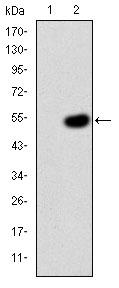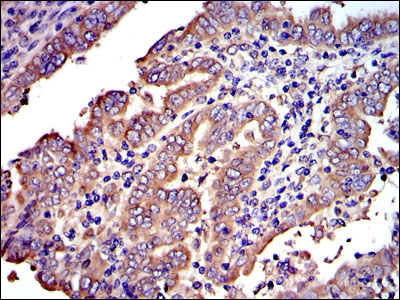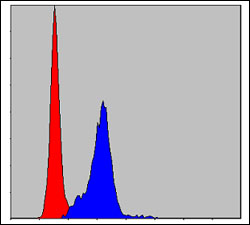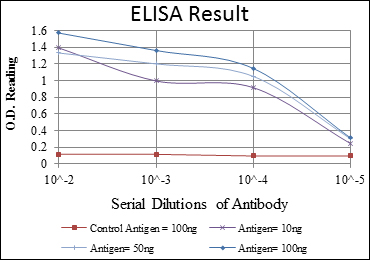Crk II Monoclonal Antibody
- Catalog No.:YM0167
- Applications:WB;IHC;IF;FCM;ELISA
- Reactivity:Human
- Target:
- Crk II
- Fields:
- >>MAPK signaling pathway;>>ErbB signaling pathway;>>Rap1 signaling pathway;>>Chemokine signaling pathway;>>Focal adhesion;>>Fc gamma R-mediated phagocytosis;>>Neurotrophin signaling pathway;>>Regulation of actin cytoskeleton;>>Insulin signaling pathway;>>Growth hormone synthesis, secretion and action;>>Bacterial invasion of epithelial cells;>>Shigellosis;>>Yersinia infection;>>Human cytomegalovirus infection;>>Human immunodeficiency virus 1 infection;>>Pathways in cancer;>>MicroRNAs in cancer;>>Renal cell carcinoma;>>Chronic myeloid leukemia
- Gene Name:
- CRK
- Protein Name:
- Adapter molecule crk
- Human Gene Id:
- 1398
- Human Swiss Prot No:
- P46108
- Mouse Swiss Prot No:
- Q64010
- Immunogen:
- Purified recombinant fragment of human Crk II expressed in E. Coli.
- Specificity:
- Crk II Monoclonal Antibody detects endogenous levels of Crk II protein.
- Formulation:
- Liquid in PBS containing 50% glycerol, 0.5% BSA and 0.02% sodium azide.
- Source:
- Monoclonal, Mouse
- Dilution:
- WB 1:500 - 1:2000. IHC 1:200 - 1:1000. IF 1:200 - 1:1000. Flow cytometry: 1:200 - 1:400. ELISA: 1:10000. Not yet tested in other applications.
- Purification:
- Affinity purification
- Storage Stability:
- -15°C to -25°C/1 year(Do not lower than -25°C)
- Other Name:
- CRK;Adapter molecule crk;Proto-oncogene c-Crk;p38
- Molecular Weight(Da):
- 34kD
- References:
- 1. Seikagaku. 2009 May;81(5):361-76.
2. Mol Cancer Res. 2009 Sep;7(9):1582-92.
- Background:
- This gene encodes a member of an adapter protein family that binds to several tyrosine-phosphorylated proteins. The product of this gene has several SH2 and SH3 domains (src-homology domains) and is involved in several signaling pathways, recruiting cytoplasmic proteins in the vicinity of tyrosine kinase through SH2-phosphotyrosine interaction. The N-terminal SH2 domain of this protein functions as a positive regulator of transformation whereas the C-terminal SH3 domain functions as a negative regulator of transformation. Two alternative transcripts encoding different isoforms with distinct biological activity have been described. [provided by RefSeq, Jul 2008],
- Function:
- domain:The C-terminal SH3 domain function as a negative modulator for transformation and the N-terminal SH3 domain appears to function as a positive regulator for transformation.,domain:The SH2 domain mediates interaction with SHB.,function:The Crk-I and Crk-II forms differ in their biological activities. Crk-II has less transforming activity than Crk-I. Crk-II mediates attachment-induced MAPK8 activation, membrane ruffling and cell motility in a Rac-dependent manner. Involved in phagocytosis of apoptotic cells and cell motility via its interaction with DOCK1 and DOCK4.,PTM:Phosphorylated on Tyr-221 upon cell adhesion. Results in the negative regulation of the association with SH2- and SH3-binding partners, possibly by the formation of an intramolecular interaction of phosphorylated Tyr-221 with the SH2 domain. This leads finally to the down-regulation of the Crk signaling pathway.,PTM:P
- Subcellular Location:
- Cytoplasm . Cell membrane . Translocated to the plasma membrane upon cell adhesion. .
- Expression:
- Embryonic lung,Epithelium,Eye,Lung,Placenta,
- June 19-2018
- WESTERN IMMUNOBLOTTING PROTOCOL
- June 19-2018
- IMMUNOHISTOCHEMISTRY-PARAFFIN PROTOCOL
- June 19-2018
- IMMUNOFLUORESCENCE PROTOCOL
- September 08-2020
- FLOW-CYTOMEYRT-PROTOCOL
- May 20-2022
- Cell-Based ELISA│解您多样本WB检测之困扰
- July 13-2018
- CELL-BASED-ELISA-PROTOCOL-FOR-ACETYL-PROTEIN
- July 13-2018
- CELL-BASED-ELISA-PROTOCOL-FOR-PHOSPHO-PROTEIN
- July 13-2018
- Antibody-FAQs
- Products Images

- Western Blot analysis using Crk II Monoclonal Antibody against HEK293 (1) and CRK-hIgGFc transfected HEK293 (2) cell lysate.

- Immunohistochemistry analysis of paraffin-embedded intima cancer tissues with DAB staining using Crk II Monoclonal Antibody.

- Immunofluorescence analysis of 3T3-L1 cells using Crk II Monoclonal Antibody (green). Blue: DRAQ5 fluorescent DNA dye. Red: Actin filaments have been labeled with Alexa Fluor-555 phalloidin.

- Flow cytometric analysis of Hela cells using Crk II Monoclonal Antibody (blue) and negative control (red).




